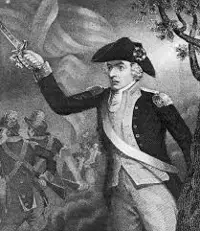Francis Marion was a Revolutionary War commander known as the "Swamp Fox" for his guerrilla tactics that he employed to harass the British in the South during the last few years of the war. Marion was born on Feb. 25, 1732, to Gabriel and Charlotte Marion, on their plantation in Berkley, S.C. Francis lived with his parents and siblings for about five years; then, the family moved to another plantation, near Georgetown, S.C. A young lad with a thirst of adventure, Marion served aboard a schooner that sailed to the West Indies; the adventure turned all too real when a whale sank the boat, killing two of the crew. Young Francis survived being adrift in a small boat for a week and vowed to remain on land. 
Like many men his age, Marion served in the British Army during the French and Indian War, for a time serving under William Moultrie. He noted with interest the tactics used by Native Americans like the Cherokee and filed the information away in case he might need it in the future. He returned to the farm after the war and then served for a time in the South Carolina Provincial Congress. He bought his own plantation, which he called Pond Bluff, in 1773. When the Revolutionary War, Marion found himself captain of a regiment posted to Fort Sullivan, near Charleston, which he and his men built. They repulsed a British invasion, and Marion spent the next three years there. After extensive training, he and his men joined Benjamin Lincoln in the Siege of Savannah in late 1779. The following year, Marion suffered a bizarre accident, breaking his ankle when he jumped out of a second-story window. He was not in Charleston when the British Army seized the town. Marion and several dozen other men later attacked the town and freed 150 Americans being held captive. Marion was also not with the main army when it suffered defeat at the Battle of Camden.  It was his success in the back country that earned him his fame and famous nickname, the "Swamp Fox." Employing the kind of guerrilla warfare that the Native Americans had used to great effect in the French and Indian War, Marion and his men (who came to be called the Marion Militia) would, using Snow's Island as a base, strike unsuspecting British troops and then melt into the surrounding countryside. 
The Marion Militia scored small victory after small victory over their British pursuers, at one point fighting alongside Lt. Col. Henry "Light Horse" Lee. One group of soldiers, led by the infamous Lt. Col. Banastre Tarleton, chased Marion and his men for 26 miles through swampland without catching them. (It was Tarleton who gave Marion his moniker.) Marion later fought under the command of Brigadier General Thomas Sumter and the overall southern commander, Nathanael Greene, at the Battle of Eutaw Springs. The British losses by this time were extensive, and the British Army pulled back to Charleston to consolidate. (They left Charleston as well, in 1782.) 
He won election to the state senate and was re-elected twice. He was known for his leniency toward Loyalists. He was later named commander of Fort Johnson. Marion's plantation was a casualty of war. He found a new home, married, and settled down. He later attended the South Carolina constitutional convention. He died at 63 in 1795. |
|
Social Studies for Kids
copyright 2002–2024
David White


